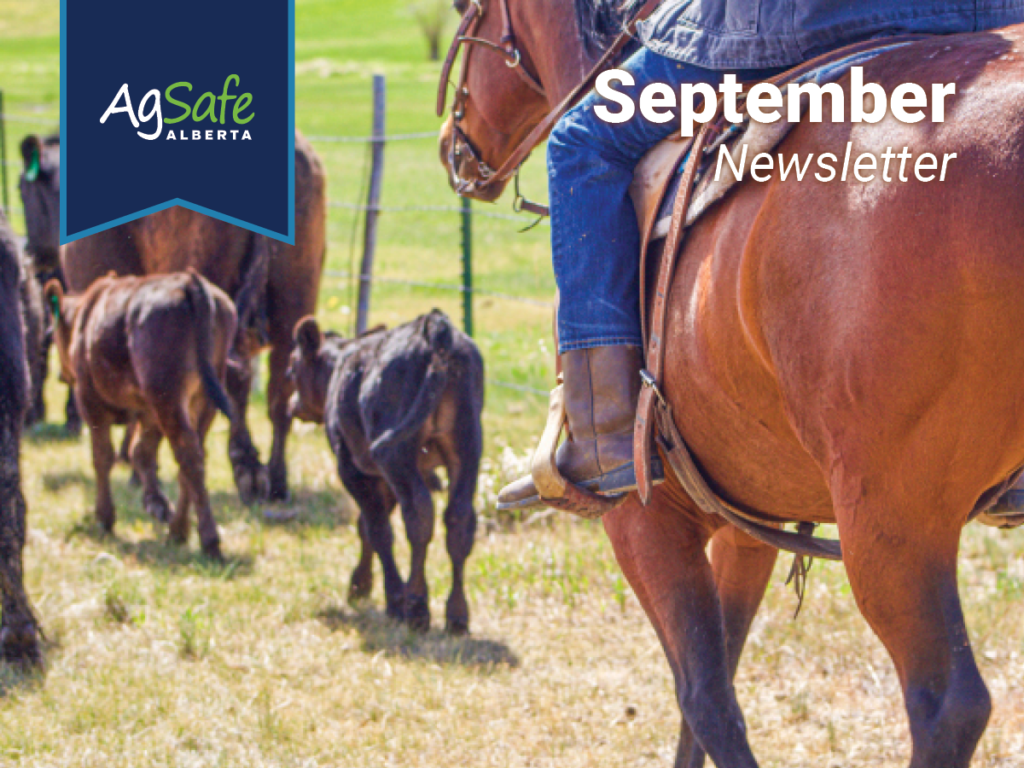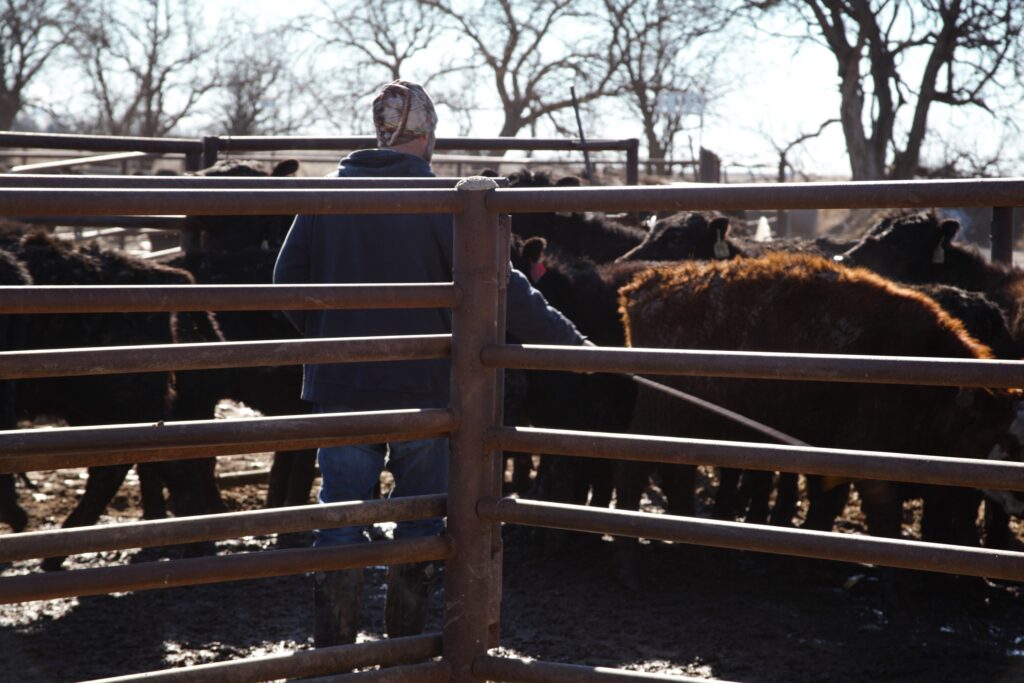
It Happened to One of Us
Hearing someone’s story in their own words is incredibly powerful. This month, watch the Fortis Alberta Powerline Safety For Farmers video and hear an Alberta farmer talk about how he lost both of his legs as the result of an overhead powerline contact.
Overhead Powerline Contact Risks During Harvest
Grain truck/trailer beds: When raised, truck beds can contact overhead powerlines. Everyone operating a grain truck on your farm should be aware of the location(s) of these lines before raising a truck bed. Ensure everyone also knows not to drive a with a raised truck/trailer bed.
Hay handling/stacking: When raised, tractor loaders may come into contact with an overhead powerline. Do not load trailers with hay near overhead powerlines and ensure hay is not stored near overhead powerlines either.
Grain augers: Portable augers and similar filling equipment should not be used within 7 metres of overhead powerlines.
What You Can Do
- Stay 7 metres away from powerlines when working.
- Before moving large equipment, plan the route and identify overhead powerlines. As you will have learned in the video, you should never measure the height of a powerline yourself; contact your utility provider to do this for you.
- Plan where bales or new grain bins will be going. Again, keep in mind that these should be at least 7 metres away from overhead powerlines.
- Where possible, bring attention to overhead powerlines. Bright sandwich boards warning of overhead powerlines can help remind custom harvest crews to ensure the grain truck/trailer beds are down before leaving or entering an area.
Get this sticker to put in your equipment from the AgSafe Alberta Store!

Harvest Toolbox Talks
AgSafe Alberta Toolbox Talk: Harvest Safety Highlights
AgSafe Alberta Toolbox Talk: Storing Bales & Handling Bales Safely
AgSafe Alberta Toolbox Talk: Entrapment and Engulfment in Grain Transport Vehicles
AgSafe Alberta Toolbox Talk: Farm Equipment on Public Roads
AgSafe Alberta Toolbox Talk: The Importance of Load Securement
Keep Human Safety A Priority During The Fall Run

Animal related fatalities remain one of the top 10 causes of death on Canadian farms1. Below are some of the factors that increase the risk of injury while working with cattle. Take a few moments to identify which ones apply to your operation and think about measures you can take to protect the health and safety of everyone working cattle.
- When individuals work with cattle with limited experience. This can happen when they do not recognize hazards and because they may be unable to properly assess the risks of the hazards they do identify.
- When individuals who have mobility issues as they will not be able to move quicky or easily enough out of harm’s way.
- When individuals are tired, have been working long hours, have been sleeping poorly or are taking medications that affect their ability to stay alert.
- When the people working cattle are older.
- Tasks that involve handling bulls.
- Tasks that involve working with cows who have recently calved.
- Tasks that involve working with cattle who have not been handled by humans very much.
- Tasks that involve moving cattle into a new environment, such as a new building or an unfamiliar cattle liner.
- Tasks where cattle are worked with in close quarters, such as when loading and unloading them for transport.
- Older farmers (over 60 years) are most at risk of injury1.
1 Canadian Agriculture Injury Reporting. (2023, February). Agriculture-related Fatalities in Canada 1990-2020. Canadian Agricultural Safety Association, pp 15. Accessed 2023, July 31 from https://www.casa-acsa.ca/wp-content/uploads/CAIR_Ag_Fatalities_1990-2020_en_V6.pdf
Calm Cattle = Safe Crew

Do
- Pre-inspect the yard; this includes gates, chains and working areas to get rid of any slip or trip hazards.
- Where possible, leave cattle that have recently been moved into a yard for around 30 minutes so they can calm down.
- Ensure cattle are fed and have access to water.
- Avoid or limit loud noises (e.g.., barking dogs, ATVs moving by quickly, etc.).
- Always stay alert.
- Wear steel-toe shoes to prevent injured toes.
- Be familiar with the flight zones and balance lines for cattle.
- Have an escape route planned.
Do Not
- Chase or beat cattle.
- Overuse electric cattle prods.
- Put too many cattle in the yard at once.
- Separate an animal from the rest of the herd unnecessarily.
- Leave gates open behind you.
- Move cattle in yards alone.
- Underestimate the speed, strength or accuracy when a bovine decides to throw a kick.
Safety First, Last Thoughts
You Might Know What You Are Doing, But Is What You Are Doing Safe?

We recognize that working with agitated, excited cattle is hazardous, but we may not Whether it comes to driving a truck, working cattle or using a grain auger, it’s easy to think we are being safer than we really are. When we do hear about someone getting injured, we brush it off as being the result of their inexperience, a lack of “common sense,” or something else that we believe could never happen to us or someone on our farm.
According to Canadian Agriculture Injury Reporting’s Agriculture-related Fatalities in Canada 1990-2020, 82% of the fatal injuries that occurred between 2011 and 2021 were people over the age of 25 years and an incredible 48% (nearly half) were over the age of 60. These fatal injuries are happening to farmers just like us, people who were raised on the farm and have been working on it for years… people who knew what they were doing.
If you have not already, go to AgSafe Alberta’s online learning platform and start the FARMERS CARE program. FARMERS CARE Levels 1 and 2 will provide you with basic safety information and practical measures that can be used to prevent someone on your farm from becoming a statistic – or worse, a memory.do everything we should in order to prevent cattle from getting distressed in the first place. We also may decide not to take certain measures because we are in a rush to get going or they may not seem very important. Consider these points:

CONTACT US
For general inquiries: info@agasafeab.ca /403-219-
For our hotline for incidence assistance: 1-833-9AGSAFE

